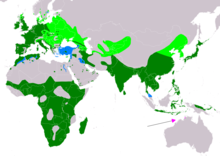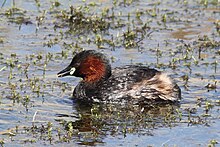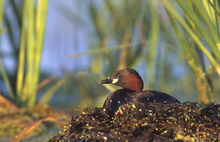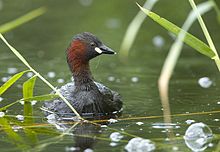Little Grebe
| Little Grebe | ||||||||||
|---|---|---|---|---|---|---|---|---|---|---|

Little Grebe ( Tachybaptus ruficollis ) in splendor |
||||||||||
| Systematics | ||||||||||
|
||||||||||
| Scientific name | ||||||||||
| Tachybaptus ruficollis | ||||||||||
| ( Pallas , 1764) |
The little grebe ( Tachybaptus ruficollis ) is a species from the grebe family . In Europe, this species, which is widespread in Eurasia and Africa, is the smallest member of this family. Little grebes are quite common in Europe. However, they are mostly overlooked because of their inconspicuous plumage and their very hidden way of life, especially during the breeding season.
A total of nine subspecies are distinguished.
Appearance
Appearance of adult little grebes
Little grebes reach a body length of 25 to 29 centimeters. The wingspan is 40 to 45 centimeters. The little grebes can weigh 130–235 g. A sexual dimorphism is only slightly pronounced. Similar to the closely related Australian Little Grebe , the males are on average slightly larger than the females and have slightly stronger beaks.
The shape of the little diver is very variable. In a calm swimming position, the feathers are set up a little, especially at the rear, so that the body appears rounded. Then the neck is hardly visible. Troubled little grebes, on the other hand, stretch their necks long. The back then lies flat on the water and can even disappear completely under the surface of the water. When flying, the little grebe lets the outstretched neck sag far below the body axis, and the legs are pulled along. Little grebes fly up very easily. The flight is fast and they usually fly at a low altitude above the surface of the water.
Splendid dress
In the magnificent dress , the upper side of the nominate form is black-brown. The skull and the back of the neck are black to black-brown. The top of the head often has a slight greenish tinge, the reins and chin are black. The throat, the cheeks, the sides of the neck and the lower neck are red-brown. The sides of the body are black-brown with light dashes. The underside of the body is glossy white with an admixture of blackish tones. The lower wings are white, the wing feathers are dark brown with a high proportion of white, so that a white mirror is visible on the wing. The tail feathers are brown-gray. The beak is black with a white tip, the corners of the beak are bright greenish yellow. The iris is red-brown, the barrel and feet are gray-green.
The plumage color on the flanks and on the underside of the body varies depending on the subspecies. Individual subspecies have yellowish-brown flanks and a silvery white belly. In others, these body parts are also black feathered. The eye color also varies. In the Asian subspecies they are yellow, in the European and African subspecies, on the other hand, they are red-brown to bright red.
Adult little grebes moult into winter plumage from August to October, but in some individuals the change can drag on until November and even December. In this full moult, the head and neck moult first. The mainsprings are all changed at once.
Plain dress
In their plain dress, little grebes are very inconspicuous in color. The plumage is overall lighter, the colors appear washed out. The upper side of the body is dark brown in the subspecies found in Europe. The chin is white, the cheeks, neck and front chest are brown with individual pale maroon spots. The rear breast and the front underside of the body are white, the rear underside is brown. The sides of the body are smoke gray. The yellow-green corner of the mouth is missing.
Asian subspecies show the red-brown color on the head sides even when they are resting. The populations in Indonesia, New Guinea and the neighboring islets, as well as in Malaysia, do not change into a resting dress, but wear their splendid dress all year round.
The change to the magnificent dress takes place in the period from January to April. It is a partial moult that covers the head, neck, body, and some elytra.
Appearance of nestlings and young birds
Newly hatched nestlings are blackish brown on the neck and back of the neck. The forehead is covered with whitish-silvery hair-like downs. The nestlings have a narrow beige to orange stripe above the eye. The chin is whitish with brown speckles. The striped pattern on the face is at Dunenjungen dwarf divers not quite as intense as about the great crested grebe and the red-necked grebe . However, the young have whitish stripes behind the eye, on the ear covers and on the chin. The rear neck and back are black and have narrow reddish beige-brown stripes. The middle of the underside of the body is white and clearly set off from the black flanks. The lid ring is grayish blue, the iris is dark brown. In the case of newly hatched little grebes, the beak is initially yellowish pink, without showing any markings.
In adolescent boys, the black on the upper side of the body turns gray-brown, the rust-red longitudinal stripes on the sides of the neck are more sharply defined. In contrast, the stripes on the back are much more washed out and the clear border between the color of the top and bottom of the body disappears. The silvery downs on the forehead remain until the forehead feather is formed. Dunenjunge change into youth clothing at the beginning of August.
In the youth dress the top of the body and head is pale dark brown. They show individual white, reddish and blackish lines on the throat, cheeks and neck, which condense on the front breast. The sides of the body are light brown, the underside of the body is white with brown dashes. The beak is gray-brown. In their first winter plumage, which they change into from September to October, young birds are even lighter on the upper side than the nobility. They appear redder on the neck and front chest. The chin and throat are white.
voice
During the breeding season, the little grebe often reveals its presence by its noticeable long trills. Both sexes have the same reputation. Often both partners even call in a duet. According Picturesque the call is a bi-iiiii ... paraphrased. The individual individuals differ significantly in the pitch, volume and duration of the individual phrase.
The call of the aggressively excited little grebe is more shrill and drops significantly in pitch at the end of the phrase. The alarm call is a sharp, metallic pit .
distribution
The distribution area extends from Western and Central Europe through Western Asia and India to China and Japan and through Southeast Asia to New Guinea . It also includes large parts of Africa and Madagascar . According to IUCN estimates, the distribution area covers a total of 36.7 million square kilometers. In this vast area, however, it is not particularly common anywhere.
In Europe, there are particularly large populations in Portugal, Great Britain, Ireland, Hungary, Poland and Romania. However, the European breeding area extends to the 63rd north latitude on the Atlantic coast of Norway. They also breed in southern Finland and Estonia. The European population is considered to be stable, but after severe winters there are occasional populations. The inventory is considered to be difficult because the little grebes lead a very hidden life, especially during the breeding season. For 1990 and 1991, the population in Germany was estimated at 6,400 to 8,000 individuals. Poland had 7,500 to 10,000 individuals and Hungary 9,000 to 10,000 little grebes during this period.
Depending on the winter temperatures of their breeding area, little grebes are resident birds, partial migrants or migratory birds. Breeding birds from Northern Europe and Central Russia to Poland and Northern Germany are predominantly migratory birds. They overwinter on the Black Sea, the Mediterranean Sea and on the Atlantic coast of Europe, among other places. In contrast, pronounced migratory birds are rare in Central Europe. Central European breeding birds typically remain within the breeding area and switch to non-freezing waters such as rivers or large reservoirs during the winter . When these waters freeze over during a severe winter, the populations of Central Europe shift somewhat to the south. Large accumulations then form, especially on the lakes of Switzerland. Occasionally up to 6,000 little divers gather on Lake Geneva.
The African populations migrate depending on the seasonal rainfall.
habitat
The Little Grebe prefers to settle in smaller still waters or slowly flowing streams or rivers during the breeding season. In Armenia and Kazakhstan, they also breed on salty lakes. A pronounced silting zone, well-developed underwater and floating leaf vegetation and a high density of aquatic invertebrates are particularly important because of the sensitivity to disturbances. They usually avoid bodies of water that are home to large predatory fish.
Outside of the breeding season, they use very different biotopes. They can then also be found on the coasts, on large lakes and ponds, on fast flowing and therefore not freezing rivers and streams.
food
Little grebes are excellent swimmers and divers and also follow fish, especially in winter. Otherwise they mostly live on insects. They peck them from the water surface or find them in the upper water layers. But they also peck them from plants or catch flying insects. They also eat molluscs more than other grebes . They also eat amphibian larvae and fry.
Reproduction
Courtship behavior
Little grebes show aggressive behavior towards other conspecifics during the breeding season, which can often be observed both during pair formation and when occupying the territories. Three basic forms can be distinguished. Threatening little grebes stretch their necks straight up. The head feathers are set up while the beak points downwards. The tail is erect and bristled. Attacking little grebes, on the other hand, stretch their heads far forward. The third element of behavior is a humpback pose, in which the head is pulled back and the beak is tilted slightly downward. The back plumage is ruffled and the wings slightly raised.
The actual courtship , which always takes place on the water, is particularly noticeable by the constant trilling of both partners as well as by fast swimming in opposite directions, parallel swimming and diving, in which they often demonstratively splash water on with their feet. In addition, there is mutual loud sham tracking, food presentation, ritualized nest building, presentation of plant material and parallel flies.
Mating takes place on the nest. The male climbs onto the lying female from behind. After copulation, the male goes over the head of the lying female onto the water or onto the edge of the nest. Then they present themselves frontally to one another, slowly turning their head to the sides or parts of the plants are presented.
Brood

The breeding season in Central Europe is from April to July. Like all grebes, the little grebe usually nests at the water's edge. The nest is usually a pile of plant parts piled up in shallow water. In deeper water, the nest is occasionally a floating nest anchored to shore plants. Both parent birds are involved in building the nest. To build nests, they use dead aquatic plants of the species that are common in the water in question. The nest has a diameter of 20 to 30 centimeters, usually it protrudes 3.5 to 4.5 centimeters above the water surface. The nest hollow has a diameter of 4 centimeters. A few meters from the main nest, they also build three to four temporary nest platforms. These are likely to be used for resting while the eggs are being laid and then incubated.
The clutch usually consists of four to six eggs. In rare cases there are clutches that contain ten eggs. The eggs are colored white immediately after they are laid, but later turn brown. Both adult birds are involved in the brood and incubation begins with the laying of the first egg. When the parents leave the nest during the breeding season, they cover the eggs with nest material.
The chicks hatch after a breeding period of 20 to 21 days. They are fed by both parent birds. The food is passed from beak to beak. The striped cubs are occasionally carried on their parents' backs, but this behavior is less common in little divers than in great crested grebes , since the young prefer to go to the nest to rest.
The young birds are independent when they are around 30 to 40 days old. However, they usually stay close to their parents. They fledge at an age of 44 to 48 days.
Hazard and protection
Population collapses among the dwarf divers mainly due to cold winters. Fluctuations in the water level also lead to reduced breeding success. Breeding site competition with species such as the red-necked grebe and the great crested grebe as well as the food competition with certain fish species play a role. Carrion crows and marsh harriers are among the predators that rob exposed nests. The chicks are also more often eaten by pike .
In addition to such natural stock fluctuations, there were noticeable decreases in stocks from the 1970s onwards. There were clear declines, for example, in the southern Upper Rhine, the Inn reservoirs, in the Upper Palatinate and in Thuringia as well as in the Austrian Waldviertel, parts of the Netherlands and the Czech Republic. This decline continues in some regions, but there has also been a strong increase regionally since the 1980s.
In particular, the destruction of natural habitats and the draining of swamps and floodplain landscapes as well as the clearing up of siltation zones have made the little grebe rare in large parts of its distribution areas. In addition, the deterioration of the habitats through intensification of the fishing industry, eutrophication and pollution of the waters, reed death and collapse of the white fish stocks as well as disturbances from leisure activities like fishing, water sports and bathing play a role. The application of pesticides such as pesticides also has an additional impact on the species, as the toxins are absorbed through food. In the vicinity of settlement areas, overland power lines and high antennas pose a danger. In some places, tourism also threatens the undisturbed breeding of birds. The little grebe is not protected by the Washington Convention on Endangered Species . In the Red List of the IUCN , the species as is "potentially at risk" out.
The little grebe is one of the species that will be particularly hard hit by climate change. A research team that, on behalf of the British Environmental Protection Agency and the Royal Society for the Protection of Birds, examined the future distribution of European breeding birds on the basis of climate models, assumes that the distribution area of the little diver will change significantly by the end of the 21st century . According to this forecast, the distribution area will shrink by about a third and at the same time shift to the north. Possible future distribution areas include central Sweden and a large part of Finland; According to these forecasts, the distribution area will also include Iceland and the coast of Norway. In contrast, a large part of the range on the Iberian Peninsula and on the northern Mediterranean coast is lost.
supporting documents
literature
- Hans-Günther Bauer, Einhard Bezzel and Wolfgang Fiedler (eds.): The compendium of birds in Central Europe: Everything about biology, endangerment and protection. Volume 1: Nonpasseriformes - non-sparrow birds. Aula-Verlag Wiebelsheim, Wiesbaden 2005, ISBN 3-89104-647-2 .
- Einhard Bezzel: birds. BLV Verlagsgesellschaft, Munich 1996, ISBN 3-405-14736-0 .
- Jon Fjeldså : The Grebes. Oxford University Press, 2004, ISBN 0-19-850064-5 .
- Collin Harrison and Peter Castell: Fledglings, Eggs and Nests of Birds of Europe. 2nd, revised edition. Aula-Verlag, Wiebelsheim 2004, ISBN 3-89104-685-5 .
- VD Il'ičev & VE Flint (eds.): Handbook of Birds of the Soviet Union. Volume 1: History of exploration, Gaviiformes, Podicipediformes, Procellariiformes. Aula Verlag, Wiesbaden 1985, ISBN 3-89104-414-3 .
Web links
- Tachybaptus ruficollis in the endangered Red List species the IUCN 2008. Posted by: BirdLife International, 2008. Accessed on December 19 of 2008.
- Videos, photos and sound recordings of Tachybaptus ruficollis in the Internet Bird Collection
- Age and gender characteristics (PDF; 1.1 MB) by J. Blasco-Zumeta and G.-M. Heinze (eng.)
- Little Grebe's feathers
Individual evidence
- ↑ Fjeldså, p. 153.
- ↑ Bezzel, p. 70
- ↑ Il'ičev & Flint: Handbook of Birds of the Soviet Union. Volume 1: History of exploration, Gaviiformes, Podicipediformes, Procellariiformes. 1985, p. 241.
- ^ Harrison, p. 35.
- ↑ Il'ičev & Flint: Handbook of Birds of the Soviet Union. Volume 1: History of exploration, Gaviiformes, Podicipediformes, Procellariiformes. 1985, p. 241.
- ^ Fjeldså, p. 154.
- ↑ BirdLife Factsheet , accessed July 8, 2009
- ↑ Fjeldsä, p. 154.
- ↑ Fjeldsä, p. 154.
- ↑ Il'ičev & Flint: Handbook of Birds of the Soviet Union. Volume 1: History of exploration, Gaviiformes, Podicipediformes, Procellariiformes. 1985, p. 243.
- ↑ Bauer et al., P. 183.
- ↑ Il'ičev & Flint: Handbook of Birds of the Soviet Union. Volume 1: History of exploration, Gaviiformes, Podicipediformes, Procellariiformes. 1985, p. 244.
- ↑ Il'ičev & Flint: Handbook of Birds of the Soviet Union. Volume 1: History of exploration, Gaviiformes, Podicipediformes, Procellariiformes. 1985, p. 246.
- ↑ Il'ičev & Flint: Handbook of Birds of the Soviet Union. Volume 1: History of exploration, Gaviiformes, Podicipediformes, Procellariiformes. 1985, p. 244.
- ↑ Il'ičev & Flint: Handbook of Birds of the Soviet Union. Volume 1: History of exploration, Gaviiformes, Podicipediformes, Procellariiformes. 1985, p. 244 and p. 245.
- ↑ Il'ičev & Flint: Handbook of Birds of the Soviet Union. Volume 1: History of exploration, Gaviiformes, Podicipediformes, Procellariiformes. 1985, p. 244 and p. 245.
- ^ Harrison, p. 35
- ↑ Il'ičev & Flint: Handbook of Birds of the Soviet Union. Volume 1: History of exploration, Gaviiformes, Podicipediformes, Procellariiformes. 1985, p. 244.
- ↑ Il'ičev & Flint: Handbook of Birds of the Soviet Union. Volume 1: History of exploration, Gaviiformes, Podicipediformes, Procellariiformes. 1985, p. 244.
- ^ Harrison, p. 35.
- ↑ Il'ičev & Flint: Handbook of Birds of the Soviet Union. Volume 1: History of exploration, Gaviiformes, Podicipediformes, Procellariiformes. 1985, p. 246.
- ↑ Il'ičev & Flint: Handbook of Birds of the Soviet Union. Volume 1: History of exploration, Gaviiformes, Podicipediformes, Procellariiformes. 1985, p. 246.
- ↑ Bauer et al., P. 184.
- ↑ Bauer et al., P. 184
- ↑ Il'ičev & Flint: Handbook of Birds of the Soviet Union. Volume 1: History of exploration, Gaviiformes, Podicipediformes, Procellariiformes. 1985, p. 246.
- ↑ Bauer et al., P. 183.
- ↑ Bauer et al., P. 184.
- ^ Brian Huntley, Rhys E. Green, Yvonne C. Collingham, Stephen G. Willis: A Climatic Atlas of European Breeding Birds. Durham University, The RSPB and Lynx Editions, Barcelona 2007, ISBN 978-84-96553-14-9 , p. 36.








